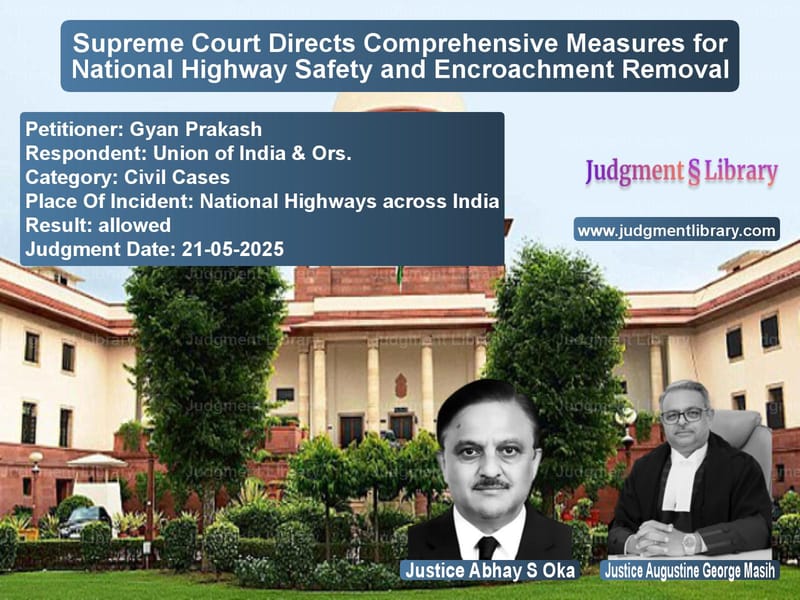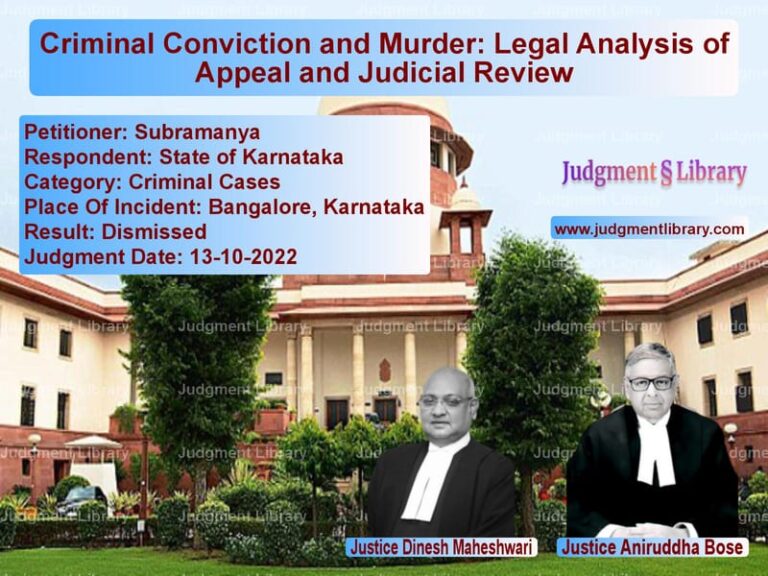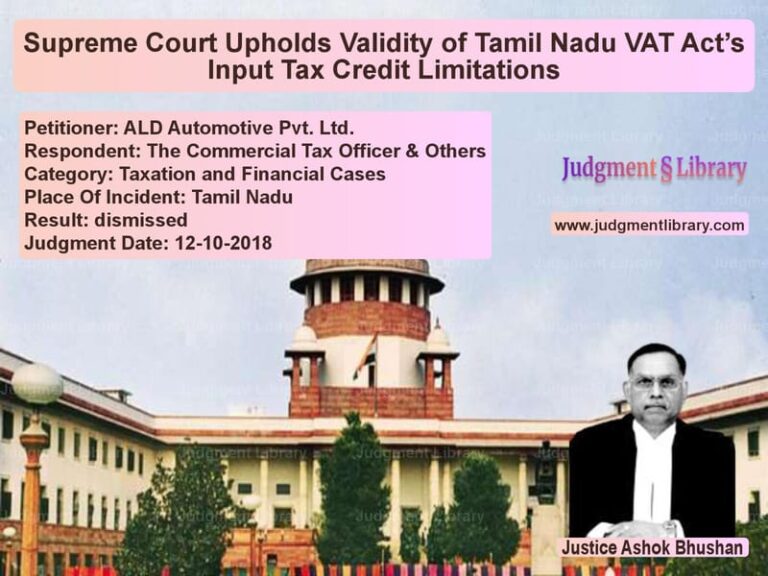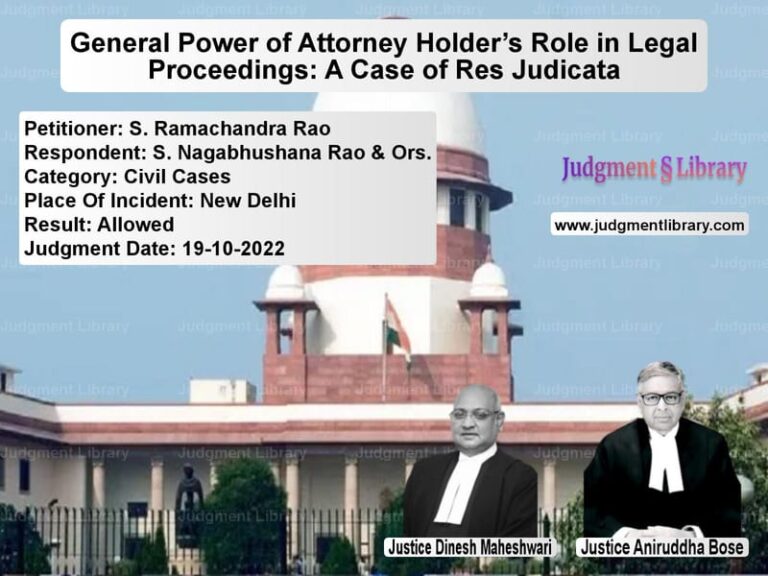Supreme Court Directs Comprehensive Measures for National Highway Safety and Encroachment Removal
In a landmark judgment addressing one of India’s most pressing public safety concerns, the Supreme Court has issued comprehensive directions to safeguard National Highways from unauthorized encroachments and improve road safety mechanisms. The case, brought before the court by petitioner Gyan Prakash, highlights the grave reality of India’s highway safety crisis, where statistics reveal that 53,181 persons lost their lives on highways in 2017 alone. This public interest litigation, filed under Article 32 of the Constitution, has evolved into a sustained judicial effort to ensure that existing legal frameworks for highway protection are implemented effectively rather than remaining merely theoretical provisions in statute books.
The court’s approach throughout this case demonstrates a remarkable commitment to transforming highway safety from a legislative concept into a lived reality for millions of Indian citizens. The bench, comprising Justice Abhay S. Oka and Justice Augustine George Masih, has been meticulously monitoring the implementation of the Control of National Highways (Land and Traffic) Act, 2002, and the Highway Administration Rules, 2004, recognizing that these legal instruments contain robust provisions that remain largely unimplemented.
The Legal Framework and Its Implementation Gap
The court extensively examined the statutory framework governing National Highways, particularly focusing on the Highway Administration established under Section 3 of the 2002 Act. This administration consists of senior officials from the Ministry of Road Transport and Highways (MoRTH), National Highways Authority of India (NHAI), and National Highways & Infrastructure Development Corporation Limited (NHIDCL). The court noted that despite this high-level composition, the implementation of critical safety provisions remained inadequate.
The court’s examination revealed that Section 24 of the 2002 Act deals with prevention of occupation of highway land, while Section 26 creates a comprehensive mechanism for removal of unauthorized occupation. The court particularly emphasized the importance of Section 26(2), which contemplates periodical inspection of highway land, and Section 26(8), which grants powers for immediate removal of encroachments when necessary for traffic safety or structural safety of the highway.
In its earlier order dated 20th February 2024, the court had made crucial observations about the implementation gap: “After reading the affidavits of the Highway Administrations, one gets an impression that the machinery is available only on paper and there is no effective implementation of the provisions of the 2002 Act.” This stark assessment set the tone for the court’s interventionist approach in ensuring that the statutory framework translates into tangible safety outcomes.
The Court’s Scrutiny of Ground Realities
The judicial process in this case involved multiple hearings and detailed examinations of compliance affidavits filed by the authorities. The court’s order dated 30th April 2024 noted the inadequacy of action taken regarding encroachment removal: “Prima facie, we are not satisfied with the action taken as reflected from the said statistics when it comes to removal of encroachments on the highways as provided in Section 26 of the Control of National Highways (Land and Traffic) Act, 2002.”
To test the claims made in compliance affidavits, the court specifically directed the Ministry of Road Transport & Highways to collect and present detailed data about inspections and encroachment removal actions from eight states: Assam, Gujarat, Karnataka, Maharashtra, Rajasthan, Tamil Nadu, Uttar Pradesh, and West Bengal. This data-driven approach reflected the court’s determination to move beyond mere assurances and examine actual implementation on the ground.
The court also noted the concerning disparity between the number of notices issued for encroachments and the actual removals effected: “From the perusal of the chart at Annexure A-5 to the compliance affidavit, it appears that though notices have been issued right from April, 2023 as regards large number of encroachments on the highways, action of removal appears to have been taken in respect of few structures/occupancies.”
Technological Solutions and Grievance Redressal
Recognizing the importance of public participation in identifying and reporting encroachments, the court in its order dated 27th August 2024 directed the creation of technological infrastructure for citizen engagement: “The Ministry shall also develop a portal where citizens can lodge complaints about the encroachments on Highways. On the portal, citizens should be able to upload photographs and location details of the encroached portions. Moreover, a facility must be also created of a toll free number to report encroachments.”
The court further emphasized the need for transparency in the process: “Action taken reports based on the complaints shall also be uploaded on the portal. It is also necessary for the Ministry to give wide publicity about the availability of the facility portal and toll-free number on all National Highways and in the media so that citizens are made aware of the facility’s existence.”
During subsequent proceedings, the court examined the existing “Rajmargyatra” mobile application and noted both its potential and limitations. The learned amicus curiae, Ms. Swati Ghildiyal, pointed out issues in the app’s functionality, including unclear complaint redressal procedures and lack of feedback mechanisms for complainants. The court directed improvements in the application and wider publicity about its availability.
Systemic Interventions and Standard Operating Procedures
The court’s directions extended beyond immediate encroachment removal to creating sustainable systems for highway safety. The bench emphasized the need for Standard Operating Procedures (SOPs) for regular inspections: “About regular inspection of the Highways, as rightly suggested by the learned amicus curiae, there is a need to issue exhaustive circulars on this aspect setting out the names and designations of the members of the inspection team, the frequency of inspections, the time intervals of inspections, allocation of highway stretches to the respective inspection teams and timely report of encroachments by the inspection teams.”
The court also endorsed the suggestion for dedicated surveillance teams: “The learned amicus curiae rightly suggested that it is necessary to constitute a dedicated surveillance team consisting of the State Police for manning the National Highways. The surveillance teams must constantly carry out patrolling so that there is no unauthorised occupation of highway lands.”
Comprehensive Directions for Highway Safety
After extensive deliberations and multiple rounds of compliance monitoring, the court issued a comprehensive set of directions in its final order dated 21st May 2025. These directions represent a holistic approach to highway safety management:
The court directed the Highway Administration to demonstrate steps taken to implement its duties under Rule 3 of the 2004 Rules, as amended in 2019. This includes formulating policies, implementation frameworks, and Standard Operating Procedures for effective highway administration.
Recognizing the importance of public awareness, the court ordered wide publicity for the ‘Rajmargyatra’ mobile application through print, electronic, and social media, with prominent displays at toll plazas and food plazas on highways.
For accountability and transparency, the court mandated the filing of detailed reports about complaints received through the mobile application and actions taken, particularly regarding unauthorized occupation of highway lands.
The court directed the creation of detailed SOPs for inspection teams, specifying their composition, inspection frequencies, allocated highway stretches, and reporting mechanisms for encroachments.
In a significant move towards proactive surveillance, the court ordered the constitution of surveillance teams comprising state police or other forces for regular patrolling of National Highways.
The court also directed the Highway Administration to consider and implement suggestions submitted by the amicus curiae, discussing them in formal meetings to ensure appropriate decision-making.
The Doctrine of Continuing Mandamus
Perhaps the most significant aspect of this case is the court’s explicit adoption of the concept of “continuing mandamus.” The court stated: “As far as this petition is concerned, it must remain pending as this is a fit case where this Court will have to issue a continuing mandamus.” This approach allows the court to maintain ongoing supervision of implementation rather than issuing a one-time judgment and closing the case.
The court scheduled the next hearing for 15th September 2025 specifically for reporting compliance, indicating its commitment to ensuring that the directions translate into concrete actions rather than remaining on paper. This judicial strategy has proven effective in several public interest litigations where sustained monitoring is necessary to overcome bureaucratic inertia and implementation deficits.
Appreciation for Public-Spirited Litigation
Throughout the proceedings, the court acknowledged the contributions of the petitioner and the amicus curiae. The judgment records: “We must record our appreciation for the persistent efforts made by the petitioner – Shri Gyan Prakash to ensure safety of our National Highways.” The court also expressed gratitude for the assistance provided by Ms. Swati Ghildiyal as amicus curiae.
This recognition is significant as it reinforces the importance of public-spirited litigation in addressing systemic issues that affect millions of citizens. The petitioner’s perseverance in bringing this matter to judicial attention and pursuing it through multiple hearings exemplifies how individual citizens can trigger transformative changes in public administration.
Broader Implications for Road Safety
While the immediate focus of the case was on encroachment removal, the court recognized the broader implications for road safety. The bench noted the connection between encroachments and accidents, observing that immediate removal powers under Section 26(8) could be exercised when necessary for traffic safety.
The court also connected this case with broader road safety initiatives, noting: “There is a committee set up by this court dealing with the issue of road safety, headed by Shri Justice Abhay Sapre, a former judge of this court. The issue of encroachments on Highways has a nexus with road safety.” The court directed that copies of its orders be forwarded to this committee, facilitating coordinated action on road safety.
The judgment represents a significant step toward making India’s National Highways safer by addressing one of the fundamental causes of accidents and traffic congestion. By ensuring the implementation of existing legal provisions rather than creating new laws, the court has demonstrated how judicial oversight can bridge the gap between legislative intent and administrative execution.
As the case continues under the court’s monitoring, it establishes an important precedent for how public interest litigation can drive systemic reforms in infrastructure safety and governance. The comprehensive approach—combining technological solutions, standardized procedures, public participation, and continuous judicial oversight—offers a model for addressing similar implementation deficits in other areas of public administration.
Petitioner Name: Gyan Prakash.Respondent Name: Union of India & Ors..Judgment By: Justice Abhay S Oka, Justice Augustine George Masih.Place Of Incident: National Highways across India.Judgment Date: 21-05-2025.Result: allowed.
Don’t miss out on the full details! Download the complete judgment in PDF format below and gain valuable insights instantly!
Download Judgment: gyan-prakash-vs-union-of-india-&-ors-supreme-court-of-india-judgment-dated-21-05-2025.pdf
Directly Download Judgment: Directly download this Judgment
See all petitions in Public Interest Litigation
See all petitions in Road Accident Cases
See all petitions in Consumer Rights
See all petitions in Damages and Compensation
See all petitions in Other Cases
See all petitions in Judgment by Abhay S. Oka
See all petitions in Judgment by Augustine George Masih
See all petitions in allowed
See all petitions in supreme court of India judgments May 2025
See all petitions in 2025 judgments
See all posts in Civil Cases Category
See all allowed petitions in Civil Cases Category
See all Dismissed petitions in Civil Cases Category
See all partially allowed petitions in Civil Cases Category







